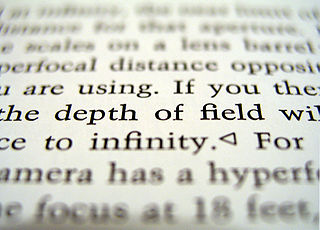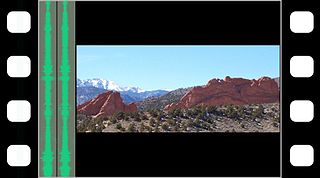
The depth of field (DOF) is the distance between the nearest and the furthest objects that are in acceptably sharp focus in an image captured with a camera.

A single-lens reflex camera (SLR) is a camera that typically uses a mirror and prism system that permits the photographer to view through the lens and see exactly what will be captured. With twin lens reflex and rangefinder cameras, the viewed image could be significantly different from the final image. When the shutter button is pressed on most SLRs, the mirror flips out of the light path, allowing light to pass through to the light receptor and the image to be captured.

A camera is an optical instrument used to capture and store images and videos, either digitally via an electronic image sensor, or chemically via a light-sensitive material such as photographic film. As a pivotal technology in the fields of photography and videography, cameras have played a significant role in the progression of visual arts, media, entertainment, surveillance, and scientific research. The invention of the camera dates back to the 19th century and has since evolved with advancements in technology, leading to a vast array of types and models in the 21st century.

IMAX is a proprietary system of high-resolution cameras, film formats, film projectors, and theaters known for having very large screens with a tall aspect ratio and steep stadium seating, with the 1.43:1 ratio format being available only in few selected locations.
Robot was a German imaging company known originally for clockwork cameras, later producing surveillance (Traffipax) and bank security cameras. Originally created in 1934 as a brand of Otto Berning, it became part of the Jenoptik group of optical companies in 1999, and specializes in traffic surveillance today.

Cinematography is the art of motion picture photography.

CinemaScope is an anamorphic lens series used, from 1953 to 1967, and less often later, for shooting widescreen films that, crucially, could be screened in theatres using existing equipment, albeit with a lens adapter.

Gregg Wesley Toland, A.S.C. was an American cinematographer known for his innovative use of techniques such as deep focus, examples of which can be found in his work on Orson Welles' Citizen Kane (1941), William Wyler's The Best Years of Our Lives (1946), and John Ford's The Grapes of Wrath, and The Long Voyage Home. He is also known for his work as a director of photography for Wuthering Heights (1939), The Westerner (1940), Ball of Fire (1941), The Outlaw (1943), Song of the South (1946) and The Bishop's Wife (1947).

Panavision is an American motion picture equipment company founded in 1954 specializing in cameras and lenses, based in Woodland Hills, California. Formed by Robert Gottschalk as a small partnership to create anamorphic projection lenses during the widescreen boom in the 1950s, Panavision expanded its product lines to meet the demands of modern filmmakers. The company introduced its first products in 1954. Originally a provider of CinemaScope accessories, the company's line of anamorphic widescreen lenses soon became the industry leader. In 1972, Panavision helped revolutionize filmmaking with the lightweight Panaflex 35 mm movie camera. The company has introduced other cameras such as the Millennium XL (1999) and the digital video Genesis (2004).
The Dalsa Origin was the first camera designed and built by Dalsa Corporation to be used specifically for digital cinematography.

The Genesis is a discontinued high-end digital movie camera developed by Panavision, and was available solely by rental. It is based on a proprietary Super 35 1.78:1 (16:9) aspect ratio, 12.4-megapixel, RGB filtered CCD sensor. It was first used by a feature crew to shoot Bryan Singer's Superman Returns, and was shortly followed up thereafter by the World War I film Flyboys. However, the computer effect-heavy nature of these two movies meant that ultimately the comedy Scary Movie 4 was the first theatrically released feature primarily shot with the Genesis. It was discontinued in 2012 and succeeded by the Millennium DXL line developed with Red Digital Cinema.

Mitchell Camera Corporation was an American motion picture camera manufacturing company established in Los Angeles in 1919. It was a primary supplier of newsreel and movie cameras for decades, until its closure in 1979.

High-speed photography is the science of taking pictures of very fast phenomena. In 1948, the Society of Motion Picture and Television Engineers (SMPTE) defined high-speed photography as any set of photographs captured by a camera capable of 69 frames per second or greater, and of at least three consecutive frames. High-speed photography can be considered to be the opposite of time-lapse photography.
Super Panavision 70 is the marketing brand name used to identify movies photographed with Panavision 70 mm spherical optics between 1959 and 1983.

Ultra Panavision 70 and MGM Camera 65 were, from 1957 to 1966, the marketing brands that identified motion pictures photographed with Panavision's anamorphic movie camera lenses on 65 mm film. Ultra Panavision 70 and MGM Camera 65 were shot at 24 frames per second (fps) using anamorphic camera lenses. Ultra Panavision 70 and MGM Camera 65's anamorphic lenses compressed the image 1.25 times, yielding an extremely wide aspect ratio of 2.76:1.

Tilt–shift photography is the use of camera movements that change the orientation or position of the lens with respect to the film or image sensor on cameras.

Anamorphic format is the cinematography technique of shooting a widescreen picture on standard 35 mm film or other visual recording media with a non-widescreen native aspect ratio. It also refers to the projection format in which a distorted image is "stretched" by an anamorphic projection lens to recreate the original aspect ratio on the viewing screen. The word anamorphic and its derivatives stem from the Greek anamorphoo, compound of morphé with the prefix aná. In the late 1990s and 2000s, anamorphic lost popularity in comparison to "flat" formats such as Super 35 with the advent of digital intermediates; however, in the years since digital cinema cameras and projectors have become commonplace, anamorphic has experienced a considerable resurgence of popularity, due in large part to the higher base ISO sensitivity of digital sensors, which facilitates shooting at smaller apertures.
James FrazierACS was an Australian inventor, naturalist and cinematographer who invented the Frazier lens. He won many Australian and international awards for his work, including an Academy Award for Technical Achievement and an Emmy Award. He is known for filming documentaries for David Attenborough together with his long-time collaborator Australian naturalist, photographer and writer Densey Clyne.

The Kodak Cine Special 16mm Cameras (CKS) are a family of precision, versatile, spring-wound 16mm silent movie cameras produced by Eastman Kodak from the 1930s to the 1960s, and intended for advanced consumers and industry professionals. While its rectangular format was typical of earlier Kodak 16 mm cameras, the CKS 'box' was formed by two joined sections: the spring motor half with the user controls, winding cranks, and gear work to the shutter. The other half was a film magazine which docked to the motor. This allowed the cinematographer to pre-load multiple magazines of film for quick interchange of film.
The Thomson Viper FilmStream Camera is a digital movie camera produced by Thomson Multimedia. Introduced in the early 2000s as makers of feature films were turning to digital cinematography, the Viper influenced subsequent HD, UHD, and HDR cameras.















